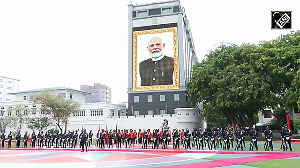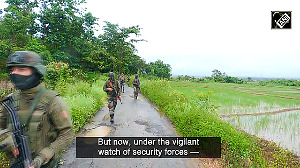'There is no one to offer jobs to the unemployed. And, there is no business for the entrepreneurs.
'As a result, technically, the recorded unemployment rate would be zero,' says Mahesh Vyas.

A fast-frequency measure based on an all-India sample often faces challenges in execution that cannot be overcome in the finite time span available to cover disruptions caused by externalities.
For example, if a region is hit by a severe natural calamity that disrupts the execution of a survey for more than a week, then it is not possible to generate a near-realtime weekly estimate for that region.
In the recent past we faced several challenges in the execution of the Consumer Pyramids Household Survey.
The worst caused by a natural calamity was in Kerala during the 2018 floods.
There were challenges in the state this year as well as there were in parts of Maharashtra and Gujarat.
These natural calamities suspend the survey for a few days or even a week or 10 days.
And then we cover up the losses during days of slack that is available in the survey execution schedule or by adding resources.
We learned through experience that weekly state-level estimates are too vulnerable to natural calamities in small states.
So, we suspended these measures.
Now, weekly estimates are available only at the all-India level and at the all-India rural and urban levels.
We retained monthly state-level estimates with the belief that no calamity would stall the execution of a household survey for an entire month.
The lockdown in Kashmir since August 5 now challenges this assumption.
A manmade affliction has stalled Jammu and Kashmir and in the process it has stalled the household survey execution in the state -- now for over a month.
We have very little communication with the CPHS survey execution team in Kashmir.
The survey depends heavily on GPS-enabled smart phones and internet connectivity.
This is a face-to-face survey that requires easy mobility of people from house to house, village to village and city to city.
None of this is possible. The survey in Jammu & Kashmir remains totally suspended.
The CPHS has a sample of 2,588 households in Jammu and Kashmir to be surveyed over a period of four months.
Of these, 784 were scheduled to be surveyed in August.
We could survey only 36 in the month.
Past surveys tell us that Jammu and Kashmir has a labour force of about 4.3 million.
The labour force participation rate was a little over 42 per cent and the unemployment rate has been mostly around 15-16 per cent.
The labour force is about 1 per cent of India's labour force and the labour force participation rate is similar to that of India, but the unemployment rate is twice as high it is in India.
In August 2019, the labour force participation rate rose a bit to 43 per cent and the unemployment rate rose sharply to 22 per cent.
But, all labour statistics estimates related to Jammu and Kashmir for the month of August 2019 are unreliable.
They are unreliable because they are based on an extremely small sample of 125 respondents from just 36 households.
“Non-response” is of the order of 95 per cent.
That is a statistically clinical explanation and it is totally unenlightening, like the estimates.
In reality, the state could be suffering a much shrunken labour force and near zero unemployment rate.
The labour force would have shrunk because when there are no tourists and when movement is highly restricted, when hotels, restaurants, transport enterprises and a host of other enterprises are forced to remain shut, they would effectively lay-off labour.
In fact, casual labour is automatically laid off.
The shikara-owners and such other self-employed entrepreneurs are all rendered unemployed.
These persons rendered unemployed by the lockdown will necessarily have to exit the labour force because there are no jobs around to look for.
Shops and offices are closed. Markets are also closed.
There is no one to offer jobs to the unemployed. And, there is no business for the entrepreneurs.
In recent surveys we recorded an estimated 650,000 unemployed persons in Jammu and Kashmir.
The sample representing these people had stated till July that they were unemployed, were willing to work and were actively looking for jobs.
How would they respond now? No one could be actively looking for jobs.
Not many would be willing to work under the current conditions.
As a result, technically, the recorded unemployment rate would be zero.
Locked in their houses, Kashmiris face no jobs, no income, no freedom but, no unemployment. Not funny.
Mahesh Vyas is the MD and CEO of CMIE.
Photograph: Faisal Mahmood/Reuters












